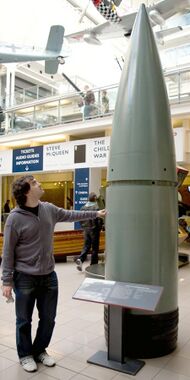Engineering:Landkreuzer P. 1500 Monster
| Landkreuzer P 1500 Monster | |
|---|---|
 Artist's rendition of the P.1500 Monster | |
| Type | Proposed super heavy self-propelled gun |
| Place of origin | |
| Specifications | |
| Mass | 1,794 t (1,978 short tons; 1,766 long tons) (800 mm gun variant) 801 t (883 short tons; 788 long tons) (600 mm gun variant) |
| Length | 25 metres (82 ft) (800 mm gun variant) |
| Width | 12.8 metres (42 ft) (800 mm gun variant) |
| Height | 8.25 metres (27.1 ft) (800 mm gun variant) |
| Crew | 100+ |
| Armour | 250 millimetres (9.8 in) (hull front) 200 millimetres (7.9 in) (hull sides) (800mm gun variant) |
Main armament | 1 × 800 mm gun OR 1 x 600mm mortar |
| Engine | 4 × Daimler-Benz MB.501 6,000 kW (8,000 hp) |
Operational range | Unknown |
| Speed | 7 km/h (4.3 mph) |
The Landkreuzer P 1500 Monster was a purported German pre-prototype super-heavy self-propelled gun designed during World War II. While it is mentioned in a number popular works about World War II projects, there is no solid documentation for the program’s existence, and it may have only been a semi-serious proposal, or even an outright hoax.[1]
Development
On 23 June 1942, the German Ministry of Armaments proposed a 1,000-tonne tank—the Landkreuzer P. 1000 Ratte. Adolf Hitler expressed interest in the project and the go-ahead was granted. In December, Krupp designed an even larger 1,500 tonne vehicle—the P. 1500 Monster. The P. 1500 was to be 25 m (82 ft 0 in) long, weighing 1,800 tonnes, with a 250 mm hull front armour, four Daimler-Benz MB.501 diesel aero engines, and an operating crew of over 100 men. This "land cruiser” would have been a self-propelled platform for the 800 mm Dora/Schwerer Gustav K (E) gun artillery piece also made by Krupp—the heaviest artillery weapon ever constructed by shell weight and total gun weight, and the largest rifled cannon by calibre.
The Schwerer Gustav fired a 7-tonne projectile up to 37 km (23 mi) and was designed for use against heavily fortified targets. The main armament could have been mounted without a rotating turret. Such a configuration would have allowed the P. 1500 to operate in a similar manner to the original 800 mm railroad gun and Karl 600 mm self-propelled mortars, launching shells without engaging the enemy with direct fire.
Issues
Development of the Panzer VIII Maus had highlighted significant problems associated with very large vehicles, such as their destruction of roads/rails, their inability to use bridges and the difficulty of strategic transportation by road or rail. The bigger the vehicle, the bigger these problems became. In 1943, Albert Speer, the Minister for Armaments, cancelled both the Ratte and Monster projects.
See also
- Crawler-transporter, the largest self-propelled land vehicles ever built
- Bagger 293, a bucket-wheel excavator and the largest land vehicle ever built by weight
- The Captain, Big Muskie and Bagger 288, previous land vehicle record holders for weight
- Overburden Conveyor Bridge F60, the largest land vehicle ever built by physical dimensions
References
- Estes, Kenneth W (2014). Super-heavy Tanks of World War II. Oxford, UK: Osprey Publishing. ISBN 978-1782003830.
- Article about the Ratte, Monster and related
- Überschwere Panzerprojekte, Michael Fröhlich, Motorbuch Verlag, 2016 ISBN:3613039257
 |
- ↑ Estes 2014, pp. 36-37.


